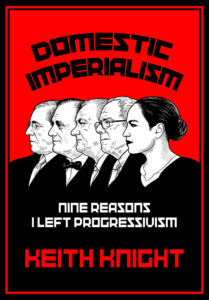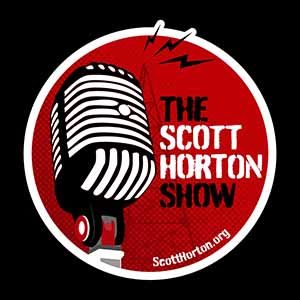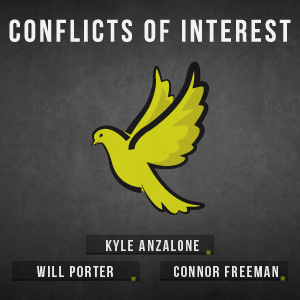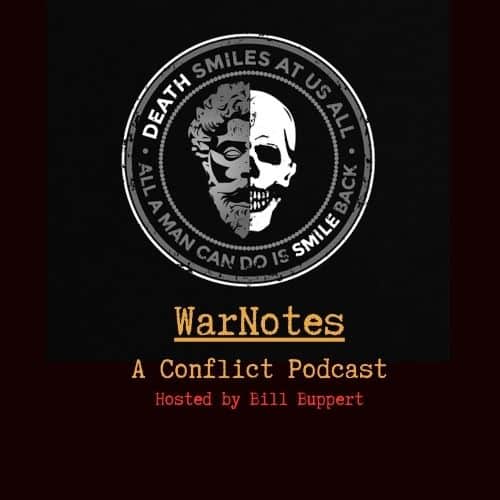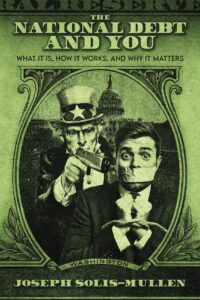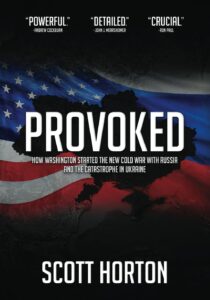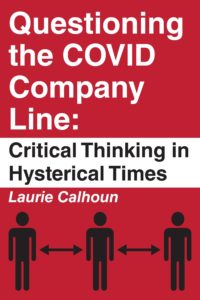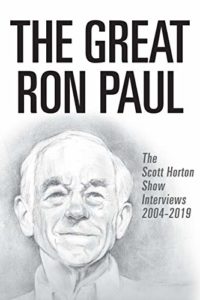In the past few months, I have reported for the Libertarian Institute on powerful American Jewish Zionists’ campaigns to unseat a sitting Republican congressman; to silence non-violent university protests against Israel’s genocide in Gaza; to blunt MAGA’s criticisms of not just Israel but of empire; to use America’s education system to mold a new elite in their image; to create a crony corporatist mecca and military surveillance colony out of New York City; and to gain influence on media and university networks in America and Britain.
The brazenness of their efforts is the most remarkable and unremarked thing about them—unremarked on because to remark on it is to invite accusations of anti-semitism. This is not by accident. The reason elite American Jewish Zionists act like they operate in a rhetorical free fire zone is because they think they do. They think this because they’ve spent thirty years and billions of dollars conflating Zionism with Judaism, so that attacking one means attacking the other. In the process, they’ve furthered the corruption of our Constitution by using big government and its postwar reliance on “big philanthropy” to gain power over the Jewish community. By doing this, they’ve endangered ordinary American Jews who are increasingly exposed to mounting public resentment against the actions of an insulated, elite few.
I have alluded to the efforts behind this play in my past seven reports on Zionist operators’ moves in favor of Israel at the expense of the American body politic. But I have not traced them to the forces that caused them—crime then finance and then, vitally, philanthropy underwritten by Washington DC, all in imitation of earlier projects of domination from British and WASP imperialists and financiers.
Understanding how this process works means beginning with the group of people on whom these forces converged to allow them to forge a carte blanche position in American political life. These operators first appeared in the national consciousness in the mid-1980s bull market, when, as I reported for the Libertarian Institute in October, real estate, Wall Street, and retail thrived off an infusion of government-backed support. They include Victoria’s Secret owner Les Wexner and Apollo Global Management’s Leon Black, Jeffrey Epstein’s patrons; and Epstein confidante Marc Rich, also a financier. They also include Charles Bronfman, of the prominent Zionist family tied to Seagram’s; Laurence Tisch, of Leows and CBS; and the hedge fund operator Michael Steinhardt, who was vital in the remaking of the Democratic Party in a pro-finance-and-Zionist-and-interventionist direction in the 1980s and 1990s. Active along with them were Ronald and Laura Lauder, the child and granddaughter-in-law of Estee Lauder. These players were joined, slightly later, by the financiers Michael Milken, Paul Singer, Robert Kraft, and Roger Hertog; and the casino magnates Sheldon and Miriam Adelson. A final major addition was the financier John Paulson, who made his fortune betting against the market in the leadup to the 2008 financial crash.
This world of Zionism and finance and politics was predicated in part on criminality. Bronfman and Steinhardt got their start in the markets thanks to support from their families, who were tied into organized crime. (Steinhardt’s father, in Steinhardt’s own telling, was a jewel fence for Meyer Lansky and funded Steinhardt’s first financial ventures. The Bronfmans were charged by American authorities for bootlegging and tax evasion in the 1930s and the family later sent illegal armaments to Israel.) Epstein left his first trading position amid questions about the legality of his trades, in a case related to purported misdoings connected to Edgar Bronfman Sr. Steinhardt came under investigation for “allegedly attempting to corner the market for short-term Treasury notes in the early 1990s,” for which he paid a penalty as part of a settlement. Marc Rich was charged with tax evasion and then pardoned by President Bill Clinton after intense lobbying from Steinhardt (who had managed money for Rich in the 1980s and 1990s) and Israeli Prime Minister Ehud Barak, another confidante of Epstein’s. The Adelsons ran into legally-colored controversy over their casino dealings, and John Paulson over his trades in the leadup to the crash of 2008.
There was also a military-intelligence angle to the criminality underway. Many of the early criminal players—especially via Meyer Lansky, a close associate of the Bronfmans—had close connections to the CIA. The connections between Zionists and intelligence services continued through the Seventies and Eighties, as I reported for the Libertarian Institute in August, especially at the hands of Ronald Reagan’s CIA director William J. Casey. For journalist Whitney Webb, who has written the definitive books on these connections, they represent “an important part of a network…composed of transgenerational organized crime interests…and major factions within both American and Israeli intelligence.” As part of her reporting, Webb has made a telling parenthetical argument: that the descendants of “the remnant of the Jewish mob” took their actions a step beyond their fathers by “promot[ing]… ethnically-focused philanthropy” for the purposes of power. It was this philanthropy that became the rhetorical cover for connected Jewish Zionists to exercise un-contested influence in American government and policy—to the detriment of Americans, Middle Eastern Muslims and Christians, and ordinary Jews.
This transition from criminality to finance to philanthropic communal control was not as difficult as it might seem. Philanthropy is often slotted as a question of private individuals doing what the government cannot—but philanthropy at the level practiced by connected Jewish Zionists beginning in the 1980s was based on government. Indeed, “big philanthropy” has functioned since the postwar period, when it was pioneered by WASPs, as part of a liberal shell game to conceal just how much investment the government has been prepared to make abroad and at home. It is a kind of CIA of the welfare world that allows government to grant special favors to specific civilian groups to test spending plans without political blowback, or, rather, with “plausible deniability.” According to the scholar of philanthropy Lila Corwin Berman, writing about the development of this trend:
“So long as state agents believed they could use philanthropy as a tool to achieve public ends, it appeared a perfect enactment of the liberal ideal and, thus, a worthy recipient of state support through tax exemptions, direct grants, and legal permissiveness…The American government could hedge its risk by encouraging a private foundation to conduct an experimental policy in India or inner-city Philadelphia, while it could also glean information about how to expand its global development or urban-renewal efforts. With few visible resources on the line, the state nonetheless tested out new ideas that might eventually be incorporated into official policies.”
This reliance increased in the late 1980s and 1990s. During that decade, “neoliberals” of the Democratic Party were trying to redirect government resources toward connected financial firms, making them too-big-to-fail, while justifying their play, falsely, in the name of cutting government. In this context, philanthropy became an even more important tool to conceal the depth of government investment “neoliberals” claimed they were paring back.
This was the pump that American Jewish Zionist financiers began to prime in the 1980s and made into a practice in the 1990s thanks to the generosity of their friends in the Clinton administration. This priming amounted to what Berman, as well as critics like Jewish Currents’ Ari M. Brostoff and Nathan Kulwin, call “a small number of Jewish community megadonors, billionaires” who used special government favors to “provide an outsize and growing proportion of funding for communal organizations and to a large extent determine what those organizations look like.” They “realigned Jewish institutions with a set of priorities never agreed upon by the wider community” and “disconnected from many of the Jews [they claim] to represent.”
The disconnect was a long way from Jewish American communities that these players had come up in during the 1940s and 1950s. These communities were largely predicated on small businesses and labor and educational organizations of an astonishing religious variety and ideological diversity, both non-Zionist and Zionist. The financial philanthropy of the 1980s and after, by contrast, was predicated on connections to New York finance and Washington politics. Its ideology was narrow and crude: the reproduction and continuity of what Jewish Currents calls “ardently pro-Israel children of two Jewish parents.” In other words, the new Jewish philanthropists were concerned with remaking the Jewish community so that it functioned as an expression of their values—and, crucially, as a justification for their public endeavors. In Berman’s academic description of the power play at work in her book The American Jewish Philanthropic Complex, these operators:
“…believed their position provided them with a platform to influence state policy, especially related to Israel. In the name of asserting and preserving a consensus-based Jewish identity, they leveraged the financial and political consolidation they had achieved and [identified] as Jewish spokespeople more visibly than ever before.”
The first site of this obsession with pushing a specific heritage on Jewish communal life was the Study Group of the 1990s. The group’s founders were Leslie Wexner and Charles Bronfman, whose members included Michael Steinhardt and Lawrence Tisch. Its purpose was to use financial fortunes via philanthropy to ensure the “right kind of continuity” for American Jews. The Study Group appears to have been part of what led Bronfman and Michael Steinhardt to found Taglit Birthright—an organization that Berman says “perfectly represented…the American Jewish philanthropic complex by the end of the twentieth century.” It represented this in three ways.
For one thing, it achieved an end desired by the U.S. government (a closer relationship between America and Israel) but not on the government’s dime. For another, it distilled the effect of a mass funneling of funds into a small community over a short time. Indeed, in the twenty years after 1999, Birthright became a staple of American Jewish life—to the point where, for young Jews growing up, it seemed to be a natural extension of the religion and ethnicity. For a third, and perhaps most important, the logic behind Birthright was a window onto the “values” which connected Jewish Zionists financiers were trying to imprint on the Jewish community.
Peering through this window means examining Steinhardt, who said, in the course of explaining his focus which led to Birthright, that “American Jews need to stop focusing on religion,” and turn instead to Israel which “has become, for me the substitute for religion,” one where “being Jewish suffuse[s] one’s entire life…in spirit and action.” This is an insight Steinhardt came to not through any actual engagement with the specifics of the Jewish tradition (or the broad range of Judaism’s ethnic palate) but instead holding a gun on a Kibbutz in 1962 at the age of 21. This was the first time, he tells us in his recent book Jewish Pride, that he experienced being Jewish other than “passively.” But Steinhardt’s conflation of ancient religious heritage with modern paramilitary pride is not unique among Zionist financial elites. The Zionist mega-donor Miriam Adelson, the child of a socialist Zionist (and so presumably an atheist) who is prominently thanked as “Miri” in the acknowledgements to Steinhardt’s book, sounded a similar note when she said that Jews had a “sacred duty” to protect Israel.
The source for this secular, martial religion propagated by Israelis to visitors like Steinhardt, who swallowed it whole, is not Jewish. The source is the British colonial elite and their American WASP imitators—a fact accessible via historical scholarship on the subject, testimonies of the WASP’s Jewish Zionist imitators, and even portrayals of this colonial elite in popular culture. And the connection between British and WASPs and Israelis is not surprising, since it was British imperialists like Arthur Balfour who helped Jewish Zionist financiers like Lord Rothschild secure Israel’s existence; and WASPs like John Jesus Angleton who helped Israel secure its dominant position in the Middle East. These imperial traditions, in the telling of their own practitioners and scholars, substitute for actual religious beliefs a commitment to “good works” on earth by a virtuous elite whose task is to “civilize” the world through conquest, commerce, and, as often as not, gender-based violence on subject populations. (Nor are the Brits and WASPs and Zionists the end of these ideologies. A later iteration of these imperialisms, the “Hindutva” supremacist outlook developed by a tiny minority of Indian elites in the course of resisting British imperialism, is a close ideological ally of Zionism today.)
Steinhardt, again, is a window into the lengths to which elite imperial operators like this will go in the name of perpetuating their “worldview” and its attendant “values.” In the 1990s and 2000s, along with backing Birthright, he attempted a foundation solely for the purpose of Zionist reproduction. The archives of this endeavor, accessible online, give a sense of its cloistered, febrile approach. Among the nineteen names under the “billionaire” lists of possible prospects for funding this foundation were seven directly from the Epstein network. The final clipping in the set of materials featured a dictum from a respected Zionist rabbi bemoaning “the effects of assimilation…and intermarriage on U.S. Jewry” and urging Zionist Jews to recreate until they numbered thirty-six million—six times the number lost in the Holocaust.
Though Steinhardt did not see this foundation through to realization, he persisted with his crude reproductive project in other ways. In 2019 he was publicly accused by The New York Times of a yearslong pattern of sexually harassing Jewish women, mostly by urging them to “put their womb[s] to work” for Judaism. Steven M. Cohen, the demographic expert favored by Steinhardt and his friends whose watchwords were “marriages” and “baby carriages,” was accused of serial sexual harassment around the same time as Steinhardt. Birthright itself was, according to a report in Jewish Currents in 2018, the site of serial sexual harassment, which is not surprising since it was meant to double as a mating site for Zionist recruits. The facts that all of these abuses both went unreported for a score of years and were largely underreported in 2019 were directly related to the power of finance transmuted into philanthropy. In one representative example, reported by the Times:
“Two women who worked at a small Jewish nonprofit…said that during a meeting at his office to make a pitch for funding, Mr. Steinhardt suggested that they all take a bath together, in what he called a ‘ménage à trois.’ One of the women, the executive director of the organization, asked that her identity be withheld because she feared that people on her board would pull their donations if she spoke publicly.”
Though his modus operandi was extreme, Steinhardt was far from the only major operator using donations to suffuse the Jewish communal world with funding for philanthropic “good works” for the higher purpose of conflating Jews with Israel. Roger Hertog, Steinhardt’s co-owner of The New Republic during the years when it pushed the invasion of Iraq, was sponsoring the Tikvah Fund. The fund is a Zionist enterprise which focuses on Jewish scholarship, and was recently the recipient, from the Donald Trump administration, of the largest government humanities grant ever bestowed on an organization. During this time, Hertog was also funding and turbocharging into a powerhouse the think tank the Manhattan Institute, whose pro-Zionist pushes at the hands of Paul Singer and John Paulson I reported on for the Libertarian Institute in August. During this time and before, Leslie Wexner was funding the Wexner Heritage Program, which since the 1980s has minted ardent Zionist operators across the country. Among these operators are Lou Weiss, Bari Weiss’s father; and the Chair of the Executive Committee of the Jewish Communal Fund.
The Jewish Communal Fund was and is its own powerhouse funder (of Zionist magazines, Zionist organizations, and Jewish organizations now infused with Zionism) with connections to match: its chair and president, Andrea Markezin-Press, is the head of the Family Office of William Ackman, a later- generation Zionist power player. So is the Jewish Federation, where Laura Lauder is a major player, and which today is responsible for funding successful legislation to conflate anti-semitism with anti-Zionism in states like California. Then there was United Jewish Appeal, whose longtime chair is the wife of the powerful Zionist Daniel Doctoroff, the deputy mayor of New York during the mayoralty of the Zionist Michael Bloomberg who, as I reported for the Libertarian Institute in February and in April, is intimately connected to Israel’s close ally the Saudi Royal Family. The Appeal was supported by, among others, the Malkin Family, the owner of the Empire State Building which partners with Robert Kraft on Zionist propaganda events run through his property. Finally, there was the Adam and Gala Milstein Foundation, which today funds aggressive pushes against “anti-semitism” which, not surprisingly, conflate anti-semitism and anti-Zionism.
The function of all of these powerful and insulated players was to conflate Jewish life with Zionist life: to tie a religious and ethnic community to a single nation-state at the heart of America’s military corporate complex. I have reported for the past few months for the Libertarian Institute on the political power grabs allowed by this conflation—and its success pushed these insulated operators to ever-more extreme ambitions.
Indeed, the exemplification of the extremes, here as in other places, was Jeffrey Epstein. The largest sum Epstein donated to Harvard, $6.5 million to the Program for Evolutionary Dynamics, reflected his special focus: “to develop an improved super-race of humans using genetic engineering and artificial intelligence.” According to several reports, he “hoped to seed the human race with his DNA by impregnating women at his ranch in New Mexico, one of his properties where young women, including minors, were allegedly abused…” This is not so far from mainstream post-1980s Zionist philanthropy as it might seem. Ari M. Brostoff and Noah Kulwin argue in Jewish Currents that “ideological echoes” exist between Epstein and other Zionist donors, suggesting that:
“…with his insemination plan, Epstein conjured a eugenicist fantasy a Nazi could love—and one that, in the context of his proximity to Jewish philanthropy, also feels like a crude parody of Jewish summer camp seen from the perspective of a megadonor.”
Anywhere else efforts like these would be recognized and condemned as open fascism. They are only tolerated in America because American Jewish Zionists have spent the last three decades staging a raw play for power by misusing a real history of marginalization. This is a conflation that many of the rest of us who identify with Jewishness or come from a Jewish heritage (I do both) would strenuously and ferociously disavow.
Indeed, the growing harms visited upon non-supremacist American Jews by this project, though far from the only aspects of this story, are major parts of it—especially as the small clique of connected Jewish Zionist operators is increasingly using its influence to silence anti-Zionism. Sometimes this silencing is done by efforts, which I have reported on in the past, funded by Laura Lauder and Miriam Adelson and Paul Singer and John Paulson among others, to penalize and silence opposition to Israel by conflating it with opposition to Jews. Sometimes—and this is increasingly the slip-on-the-banana-peel aspect of the project—it is done by taking the project’s supremacist logic to its conclusion. Namely, essentializing other groups as irremediably “bad” in exactly the way Jews were essentialized themselves in still-living memory.
Two examples make the point plain. In July, as Palestinians reached the point of starvation in the Gaza strip, the New York Post’s Seth Barron argued to me publicly that the reason he found the Palestinian cause “boring” was that “Palestinianism” had an “essence” and “typology” which was “victimhood.” In October, as a nominal “peace” in Gaza was established stopping the most immediate deaths, posts circulated on X of the prominent American Jewish Zionist journalist Josh Hammer arguing publicly that “Jew-hatred is inherent in the European DNA” and that “Jew-hatred is inherent in [Europe’s] collective DNA.” Yet these public comments of Hammer’s were circulated even as private texts of Hammer’s were also circulated in which he forensically scolded a fellow conservative for what he called this conservative’s mild approach to a podcast guest who argued that COVID was a “Jewish disease.” Here the slip-on-the-banana-peel aspect of Barron’s and Hammer’s project comes into view. The “Jewish disease” comment is a cousin of the “blood libel” discourse used to justify pogroms in Europe until eighty years ago. These in turn, though the target is different, are ideological cousins of Hammer’s comments that “Jew hatred is inherent in the European DNA.” What’s to stop Hammer’s logic from rebounding back on Jews? If essentialism is anything, it’s a two-way street.
Indeed, in the face of rhetorical moves like these, some Americans opposed to Zionism and its influence on American institutions are increasingly inverting the conflating, essentializing logic being pushed on them from above. They are saying that Judaism and Zionism are the same thing, and that both are very, very, and very intrinsically, bad. The burden of this conflation will not be borne by connected Jewish Zionists with private jets and penthouse security. It will be borne by ordinary Jews who are not insulated by power’s trappings from hatred and harm; the very people elite Jewish Zionists claim, falsely, to represent.
This is the legacy wrought by the Zionist financiers who used philanthropy to take over the Jewish community. It is a problem for Jews but it is not a Jewish problem. It is a problem of postwar American government and its corruption at the hands of military and financial networks of concentrated and unconstitutional political economic power. It is something our Founders, were they teleported to the present, would have no trouble recognizing. In this sense, the problem faced by Jews is also a microcosm of the paralysis that centralized power wreaks more broadly on communities of our constitutional republic. When elites of any tradition use government to seize control, they rarely end up on the receiving end of the backlash that comes from their actions. The brunt, instead, is borne by the ordinary people they claim to represent to justify their climb.

